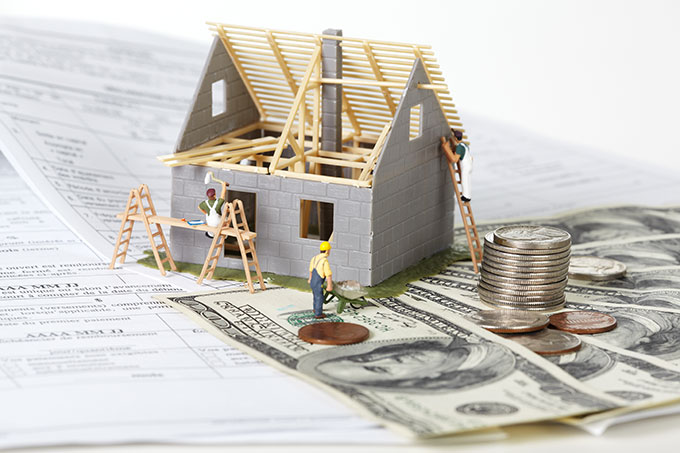BUSINESS
This is how you can finance the construction of your own home

Live in a home owned, independent and, possibly, away from the hustle and bustle of the city. This desire, to leave behind contact with the crowds that live in large cities, has become stronger since the start of the health emergency caused by the covid pandemic. However, if instead of buying an old home you prefer to build a new one, in many cases the savings are not enough for the land and the building. For this reason, there is a peculiar class of loans whose guarantee is not an already built home, as in common mortgages, but a house of which only the project exists. It is the so-called self-promoter mortgage, a niche product whose trend, however, is on the rise, according to experts.
“The demand for self-promoting mortgages is much lower than that of a conventional mortgage loan,” says the director of Mortgages at iAhorro, Simone Colombelli. These represent only a small part of the mortgages contracted through this bank comparator. However, for the secretary of the General Council of real estate agents (Coapi), Lola Alcover, “in the last year it has been possible to see an increase in demand, undoubtedly closely linked to the increase in interest in single-family homes that the current health crisis, with everything that has come with it, has meant”.
But, what are the requirements to apply for a self-promoter mortgage? Beyond having the economic solvency require by the bank to grant a loan, the user must be the owner of the land on which he plans to build his home and this must be register in the Land Registry. “The land must also comply with all the urban planning regulations that are applicable in each specific case and have the building permit, processed before the town hall,” explains Alcover. And you will have to provide a project for the execution of the work carried out by a competent technician like boom & bucket and with the collegiate visa, as well as a budget.
Basic bindings
“In the vast majority of cases, with a self-promoting mortgage you can get the same level of financing as with a regular mortgage loan, that is, up to 80%,” says Colombelli. That money, however, will not be deliver all at the beginning, but in a staggered manner. The usual thing is that the first contribution occurs at the time of signing the mortgage and before starting the work, and that it covers 50% of what is establish in the contract. “That money will be use to pay for all the costs of buying materials and starting construction,” explains Alcover.
Each time the successive stages of construction are finish, the technical director will issue the corresponding work certifications, which will be transfer to the entity to certify the completion of one of the sections. In this way, the user will receive from the bank the money planned for the next phase. When the execution of the project ends and the certificates are issue, as well as the occupancy certificate, the last tranche of financing will arrive, which generally ranges between 10% and 20%.
As for the other characteristics of self-promoting mortgages —marketed, among other entities, by Banco Sabadell, Bankinter, Liberbank, Unicaja, Globalcaja, Targobank and Banca Pueyo— Colombelli points out that they are very similar to typical mortgage loans. “In the vast majority of cases, the links are usually the basic ones: payroll, life insurance and home. The most frequent term is usually 30 years and the interests are similar to those of the rest of mortgages”, says Colombelli.
“There are also many firms that set a slightly higher interest, considering that the risk assumed is higher than in the traditional format, since they are talking about a building in the future, with the consequent uncertainty of whether at final will count or not with the guarantee of the property. However, when this increase occurs, it moves in a range that does not usually exceed half or three quarters of a point”, Alcover warns.
Uncertainty
Colombelli stresses that when requesting a self-promoting mortgage “the land must be purchase, except in the case of Banca Pueyo, which offers to cover up to 70% of its price, and Unicaja and Targobank, which grant up to 50% %”.
The experts consulted agree on the advantages of this type of loan. “We have the flexibility to define the project and even for the conditions of the loan with an entity that does not have a specific range of this product,” says Colombelli, from iAhorro. To which Alcover, from Coapi, adds the fact that “the amounts are receive in stages and, therefore, the indebtedness goes hand in hand with the good evolution of the define company; and that during the first two years capital is not amortize, but only the fixed interest, which makes the start of the project more affordable”.
However, some inconvenience must be take into account. “If we take into account all the setbacks that may arise throughout the process, such as unexpect changes in materials or delays in the work, among others, and not having a close budget, it is possible that the process is costly and a deviation between the project and the finish work; and it is on the latter that the appraisal is carry out”, warns Colombelli. To balance the uncertainty that this generates, “the entity will be more rigorous in the require solvency conditions and it is very common for guarantees to reinforce the guarantee to be request, which is another disadvantage to take into account,” Alcover emphasizes.
